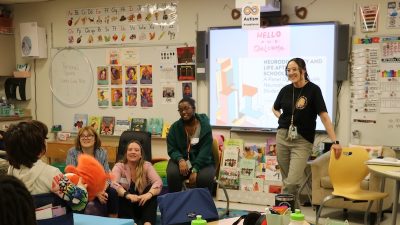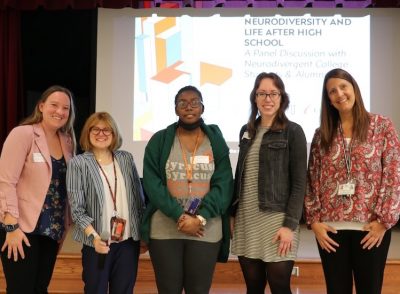A special curriculum theme on neurodivergence resonated with students at Dr. Weeks Elementary School in the Syracuse City School District (SCSD), supporting the school’s goal to raise awareness about autism and other forms of neurodivergence and to promote acceptance about those who learn differently.
 Caley Kutz G’12, the 15:1 self-contained fifth-grade special education teacher, along with fourth-grade teacher Kelcey Myers G’23, were the driving force behind a month-long initiative to educate students on neurodiversity and to honor their neurodivergent classmates.
Caley Kutz G’12, the 15:1 self-contained fifth-grade special education teacher, along with fourth-grade teacher Kelcey Myers G’23, were the driving force behind a month-long initiative to educate students on neurodiversity and to honor their neurodivergent classmates.
Because Principal Diane Vitello makes a concerted effort each month to honor differences among her school population, the pair pushed to dedicate April 2024—National Neurodiversity Celebration Month—as the month to expand awareness in their school.
It’s OK to Be Curious
A graduate of SOE’s Inclusive Special Education (Severe/Multiple Disabilities) program, Kutz explains, “We have a very diverse population here, especially a growing population with autism,” noting the school recently added an 8:1:1 autism room. “We thought that the neurodiverse population is overlooked and not discussed much, so we wanted to generate greater student understanding—as well as staff understanding—of this population.”
The pair figured that inclusion starts with educating about neurodiversity, so they set out to answer basic questions for an elementary-aged audience, reinforcing that it is OK to be curious. They encouraged all students to ask questions such as, What does it mean to be neurodiverse? What does it look like? What does it feel like? How can you be inclusive and include your peers?
“We were able to have some really cool conversations in class,” says Myers, a graduate of SOE’s Literacy Education program. For example, she discussed with students that while they may see someone using a wheelchair or voice assist device, there are some disabilities they can’t see. “We discussed invisible disabilities—such as ADHD and Tourette’s—and how diverse the neurodiversity population can be and how unique it is.”
“Having a holistic approach to inclusion at all levels really moves the system forward.”
Professor Beth Myers
Additionally, Kutz pulled together resources to share with other teachers for use in the classroom, while for school announcements each day, a neurodivergent celebrity was introduced—including star gymnast Simone Biles (who has ADHD) and singer Billie Eilish (Tourette Syndrome).
It’s Normal for So Many People
The month-long theme culminated with an autism awareness assembly organized in collaboration with Syracuse University School of Education’s (SOE) Center on Disability and Inclusion (CDI).

The Assembly welcomed back to Dr. Weeks former English Language Arts teacher Chelsea Stinson G’17, G’22, and her academic colleague Katie Ducett G’23, both graduates of SOE’s inclusive education doctoral program and now assistant professors of inclusive education at the State University of New York at Cortland.
The pair led a discussion focusing on disability rights, what neurodivergence means, and what students can do to support their neurodivergent friends. The event also included former and future InclusiveU students Olivia Baist ’22 and Melanie Moore ’28, who spoke about what it’s like to attend college as an autistic student.
“When the teachers organized the event, I jumped at the chance to participate,” Stinson says. “I have a relationship with CDI, and I taught for years at Dr. Weeks before completing my Ph.D. at Syracuse. The assembly sounded like a great opportunity to bring neurodivergent students from inclusive higher education into that space.”
Moore says she was eager to inform other SCSD students and their families about the opportunities neurodiverse students have through OnCampus, a partnership between SCSD and SOE’s Lawrence B. Taishoff Center for Inclusive Higher Education, which also directs InclusiveU.
OnCampus provides city school students an opportunity for academic, personal, and social development on the Syracuse campus and is often a pre-cursor to four years in InclusiveU.
At the assembly, Moore explained that neurodivergence is when someone learns in different ways. “Some people’s brains work differently,” she told the students. “It’s normal for so many people, and we need to be accepting of others who are neurodivergent—like me!”
Let Your Friends Know
Moore gave the third- through fifth-grade students specific examples of her learning style: “When I do not understand something or need extra help I ask my mentor, AnnMarie Stark.”
“We wanted to generate greater student understanding—as well as staff understanding—of this population.”
Caley Kutz G’12
She also described how her mentor can break down information into smaller chunks or reinforce ideas using supplemental examples, helping her brain to better understand: “Sometimes after I read something, I don’t understand. AnnMarie will show me a picture or a video about what it is. Then my mind can recognize and learn in two different ways.”
For many neurodivergent students, sensory overload can be a challenge, Moore explained. Taking breaks or using fidget devices can help regulate stimulation and, in turn, improve focus, reduce anxiety or stress, and help regulate emotions. “Sometimes I need to remove myself from areas that have a lot going on,” shared Moore, who likes to study in a quiet space. She says the Syracuse campus has several spaces for her to do this: “Let your friends know your preference. It’s OK to ask for help at any time.”
SOE Professor of Inclusive Education and Taishoff Center Director Beth Myers says that these types of community collaborations can be life-altering: “From students completing our inclusive teacher preparation programs to those attending On Campus and InclusiveU, to the graduates of our Ph.D. program, having a holistic approach to inclusion at all levels really moves the system forward.”
Kutz agrees, and credits SOE with helping her prepare for her role in diverse and inclusive classrooms.
“I had really great field experiences through Syracuse University,” she says. “I worked at the local Jowonio and Bernice M. Wright schools and got to see a younger population of students with autism. With neurodiversity, I was typically just looking at middle elementary age, but these experiences gave me a full range of little itty bittys and pre-K.”
By Ashley Kang ’04, G’11 (a proud alumna of the M.S. in Higher Education program)
